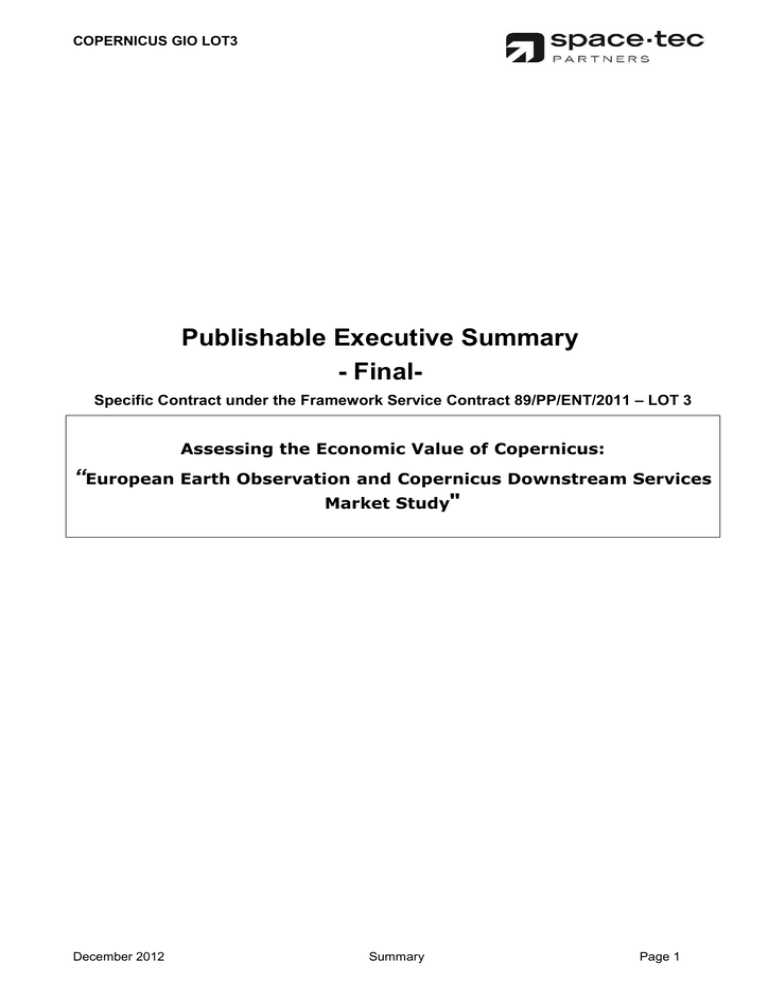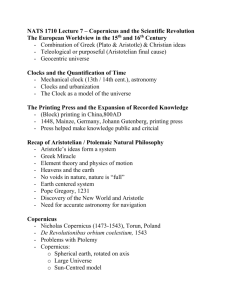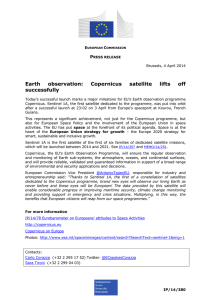Assessing the Economic Value of Copernicus: "European Earth
advertisement

COPERNICUS GIO LOT3 Publishable Executive Summary - FinalSpecific Contract under the Framework Service Contract 89/PP/ENT/2011 – LOT 3 Assessing the Economic Value of Copernicus: “European Earth Observation and Copernicus Downstream Services Market Study" December 2012 Summary Page 1 COPERNICUS GIO LOT3 CONTENTS 1 INTRODUCTION............................................................................................................................ 3 2 STUDY OBJECTIVES ................................................................................................................... 3 3 KEY ASSUMPTIONS AND ENABLING FACTORS ...................................................................... 3 4 KEY FINDINGS ............................................................................................................................. 5 4.1 Market Overview........................................................................................................................ 5 4.2 Sector Analysis ......................................................................................................................... 6 4.3 EO and COPERNICUS Downstream Market Potential ............................................................ 8 4.4 Impact on Employment ........................................................................................................... 11 4.4.1 Downstream Direct Employment ............................................................................................................... 11 4.4.2 Upstream and Midstream Direct Employment .......................................................................................... 12 4.4.3 Aggregate Employment Impact ................................................................................................................. 13 5 CONCLUSIONS........................................................................................................................... 15 6 REFERENCES ............................................................................................................................ 17 December 2012 Summary Page 2 COPERNICUS GIO LOT3 1 INTRODUCTION This document presents the summary of the Final Report of the “European Earth Observation (EO) and GMES Downstream Services Market Study”, performed under the first Specific Contract of the Framework Service Contract 89/PP/ENT/2011 – LOT 3 (“Support to GMES related policy measures”). It contains a high-level summary of key findings of the analysis of the potential market value for European Earth Observation and GMES1 downstream services for the Non-Life Insurance sector. 2 STUDY OBJECTIVES In the context of Copernicus programme implementation, several studies have been carried out, focusing on costs and benefits in the context of European Commission (EC) regulatory actions. Independently, industry surveys and market analyses have described the state and structure of the Earth Observation market. However, the economic value of these markets in relation to Copernicus has not yet been the subject of detailed investigation, particularly with regard to the potential impacts on growth and employment. The specific objective of the study is to assess the potential market value for European Earth Observation and Copernicus downstream services (with a focus on non-institutional markets), and the potential resultant impact on employment. The study seeks to project the future markets for downstream services over a long-term time horizon (2015-2030). 3 KEY ASSUMPTIONS AND ENABLING FACTORS The study is subject to the following key assumptions: 1. Catalytic effect of free and open data provision2: Copernicus services are expected to enable and stimulate the downstream sector by freely and openly providing access to basic pre-processed data and modelling outputs, more cheaply than would be the case if companies had to undertake such basic processing and modelling themselves. The business case for COPERNICUS is that the services improve the efficiency of the downstream sector, allowing the industry to offer better value for money in products and services to end users. 2. Full and assured continuity of Copernicus: In order for the potential of future markets for Earth Observation downstream services to be realised, the continued long-term availability of Copernicus data services is assumed. The investment incentives are crucially tied to both political and financial commitments at an institutional level. This continuity of services presupposes the continuity and evolution of Copernicus infrastructure providing the necessary data. Without continuity, the "raison d'être" of Copernicus is put into question, as users will only rely on Copernicus if a sustained flow of data is ensured. Without appropriate funding, existing services will cease their activities. Furthermore, a set of enabling factors has been identified, on which action and associated investments are considered necessary for the realisation of downstream market potential. Certain 1 GMES will hereafter be referred to as Copernicus, following the recent decision by the European Commission to change the name of the programme (as per http://europa.eu/rapid/press-release_IP-12-1345_en.htm). 2 This refers, in the first instance, to data derived from the Copernicus family of dedicated satellites, the Sentinels. The transitory phenomenon of Contributing Mission data will be dealt with in a follow-on study on the midstream, scheduled for 2013. December 2012 Summary Page 3 COPERNICUS GIO LOT3 institutional conditions are necessary to enable and accelerate the market dynamics foreseen in this study, linked, inter alia, to market development and capacity building. They are summarised below: a. Regulation: Free and open data policy; assurance of data continuity; quality assurance and standards-building. b. Data Availability and Access: Simplified access to Copernicus Sentinel datasets at ready-touse processing levels (L1)3 for high-volume distribution, thereby responding to the needs of the value-adding industry, ideally avoiding the duplication of efforts at national level. c. Demand/Market: Continued dissemination efforts; regional/local demand incubation and communication schemes aimed at commercial users; federation / consolidation of user needs and industry requirements; further integration of EO information as a supplement to traditional systems. Examples of relevant enabling activities, which already exist in Europe, include: Tools for Copernicus Sentinel data pre-processing, which are already being piloted in selected Member States. The provision of support to the promotion of Space applications-related ideas (e.g. GMES Masters) and business incubators. Easy access to credit for entrepreneurs willing to invest in the value-added service sector. Support to training programmes in geospatial sciences to ensure availability of necessary talents for these applications. The building of networks and the organisation of dedicated events to consolidate user needs and industry requirements. These activities should be built upon, extended and promoted in order for the full potential of the market to be realised. Under the EU’s Horizon 2020 strategy, “it is expected that around 15% of the total combined budget for all societal challenges and the enabling and industrial technologies will go to SMEs”4. 3 L1 includes geometric and radiometric pre-processing. 4 COM (2011) 808, final, p. 10. December 2012 Summary Page 4 COPERNICUS GIO LOT3 4 KEY FINDINGS In this study, the Earth Observation value chain is divided into three areas of activity, each with specific markets, actors and industry structure: 4.1 Upstream refers to the providers of EO Space infrastructure, comprising satellite and ground system manufacturers and operators, as well as the providers of launch capabilities. Midstream refers to data providers, who make use of upstream infrastructure for commercial and institutional purposes. The core activities include the acquisition, production, processing, archiving and distribution of Space-derived data. Downstream represents companies offering Value-Added Services (VAS). Such companies typically develop commercial applications based on EO data provided by the commercial data resellers. Market Overview The European EO downstream market is currently estimated at € 0,7 Bn, against € 0,2 Bn for the midstream and € 0,6 Bn for the upstream. According to a study published by Euroconsult, the EO downstream market will, in 2015, reach approximately € 1 Bn in Europe (and over € 2 Bn globally), growing at a Compound Annual Growth Rate (CAGR)5 of 7%. Figure 1: Earth Observation Downstream Services Market Forecast 5 The Compound Annual Growth Rate expresses the smoothed annualised growth rate of an investment or of a business element (in this case, industry turnover). December 2012 Summary Page 5 COPERNICUS GIO LOT3 4.2 Sector Analysis The present study used Eurostat’s NACE6 taxonomy as a basis for the identification of potential industrial application areas for Copernicus downstream services. Five initial pilot sectors, considered to have a high market development potential, have been selected for priority analysis: 1. Agriculture A cost-benefit analysis7 shows that net economic benefits of more than € 5 per hectare can be achieved, thanks to savings in nitrogen, better crop quality (increased protein content) and increases to overall crop yield. A positive environmental impact is also gained by avoiding the dispersal of excessive nitrogen into the water, air and soil. 2. Non-life insurance Continuous and reliable Earth Observation information can play a role in reducing costs and introducing efficiencies in non-life insurance business processes. Remote sensing information can substantially improve the accuracy of catastrophe models, thus helping insurers to improve risk management and compliance practices. In addition, claims management functions can be supported by damage or disaster assessment information supporting loss quantification and exposure mapping. 3. Oil and gas In the oil and gas sector, Earth Observation exploitation is currently still limited. Satellite imagery and GIS systems can, however, usefully complement geological surveys and improve the readability of complex geoscience datasets, used by engineers in order to identify areas where it is geologically likely that petroleum or gas deposits might exist. Moreover, satellite imagery can contribute to improved asset management: seismic planning and subsidence mapping help to highlight geo-hazard risks and to ensure safer management of reservoirs and pipelines. 4. Water transport In the water transport sector, Earth Observation information offers benefits through a number of different applications. Satellites provide continuous and large-scale information about sea currents, which can be converted into current forecast models. These models allow ships to optimise their routes, yielding fuel efficiency benefits and the reduction of CO 2 emissions. Satellite imaging applications can also improve traffic management in major ports and harbours. 6 NACE is a standardised classification system for describing economic sectors and their activities in the European Union. The second revision of the NACE taxonomy has been used in this study. 7 Knight et al., 2009. December 2012 Summary Page 6 COPERNICUS GIO LOT3 5. Electricity generation from renewable sources Earth Observation can contribute to the optimisation of renewable energy systems for power production, and to the provision of information for optimal integration of traditional and renewable energy supply systems into electric power grids. Energy sources such as solar, wind, and wave power facilities, which offer environmentally-friendly alternatives to fossil fuels, are particularly sensitive to environmental conditions. Data on cloud cover, solar irradiance, and on wind/wave speed and direction (combined with other environmental parameters such as land elevation and land cover models) are vital elements in developing a strategy for the location and operation of solar, wind, and wave power facilities. Examples of practical downstream applications in these sectors include solar power site selection and plant monitoring, damage assessment for insurance claim management, oil pipeline encroachment monitoring and precision agriculture maps. These and many other examples of the use of EO data demonstrate that the free and open provision of Copernicus data is an essential driver for the creation of new business opportunities. The long-term market potential for these pilot segments has been assessed through the concept of the Total Addressable Market (TAM). This concept expresses hypothesised market penetration, under specific assumptions and within certain limitations. It serves as a metric of the underlying revenue potential of a given opportunity, and should be treated as a “bounded theoretical maximum”. The approach and key inputs for the estimation of the EO downstream services’ Total Addressable Market for each pilot segment are illustrated in the following table. Table 1: Approach and Key Inputs for Estimating EO Downstream Market Potential The results of the analysis performed for the five pilot market segments are illustrated in the following figure. December 2012 Summary Page 7 COPERNICUS GIO LOT3 Long Term Forecast EO Downstream Services Market Potential in Europe (Selected Market Segment Analysis, Indicative Figures of Turnover in € Million) 1200 €M 972 1000 72 RES Electricity 800 449 Agriculture 600 75 400 171 101 200 204 Non-life insurance Extraction of crude oil and natural gas Water transport 0 Current Market Total Addressable Market TAM= Total Addressable Market Source: Eurostat, Euroconsult (2011), Industry Interviews, STP Analysis. Figure 2: Long Term Forecast EO Downstream Services Market Potential for the 5 Pilot Segments The approach used for the pilot sectors has been applied to the wider European economy by qualitatively evaluating the remaining NACE segments on their potential for uptake of EO value-added services. 15 out of the 21 top-level NACE sectors have been identified as being strong candidates for EO downstream service applications. The demand potential is moderate to high for more than half of these sectors. The total turnover of these sectors represents 19% of European GDP. 4.3 EO and Copernicus Downstream Market Potential On the basis of the selected industry sectors and EO relevance analysis, expert interviews and information from previous studies, the total European EO downstream market potential has been assessed. The analysis has resulted in the identification of an indicative economic factor (EO downstream Total Addressable Market as % of European GDP) and a total estimated EO downstream long-term market potential of € 2,8 billion, as shown in the scheme below. December 2012 Summary Page 8 COPERNICUS GIO LOT3 European EO Downstream Services Market Potential Estimation Methodology Long Term Forecast Based on Total Addressable Market Analysis Priority Industry Sectors Analysis Conceptual Total Commercial EO DS TAM Calculation Agriculture Insurance 0,02% Extraction of Oil & Gas 11% (Purchases of goods & services of relevant NACE segments as % of GDP EU GDP) Water Transport Estimated Total Addressable Market (with different approaches as deemed Estimated appropriate on the basis of Total Addressable Market* industry characteristics) Derived Factor Industry interviews Consistency checks Validation and Calibration % of EO Downstream Services Turnover/ Purchase of Goods and Services= 0,2% 0, 2% Derived Factor Total EU GDP 0,02% Total EU GDP** EO DS TAM Factor as % of EU GDP €2,8 bn (*): with different approaches as deemed appropriate on the basis of industry characteristics; (**): Equal to €12,6 trillion in 2011 Sources: Euroconsult,Eurostat, Industry interviews, STP Analysis Figure 3: Methodology for Estimation of European EO Downstream Services Market Potential Due to the nature of the TAM concept as well as to the uncertainty of future market projections, it is difficult to predict when the estimated potential will be reached. Therefore, the potential growth scenarios have been calculated in two example cases (2015 + 10 years and 2015 + 15 years, resulting in a CAGR of 11% and 7% respectively). These results have been triangulated with data from other studies, including Euroconsult (2010, 2011). The potential growth rates of EO downstream markets display consistency with the projected growth rates drawn from these sources. In order to derive the Copernicus downstream market potential the following considerations must be highlighted. The downstream services and applications considered in the analysis do not, in general, require Very High Resolution (VHR) data, i.e. the required resolution for these services is higher than 2,5 meters. Only a small fraction (approximately 10%) of the commercial downstream services for the different sectors would require VHR data as an input. This fraction is therefore excluded from the analysis of the addressable markets resulting from the availability of Copernicus services. Copernicus is expected to provide impetus to the downstream services industry by offering specific technical advantages through the Sentinel satellites along with free and open access to data. This can represent an incentive for new users as well as downstream service providers to engage in EO service solutions. Copernicus may to some extent impact the (less valuable) EO data market for non-VHR (5% of total EO data sales market value) served by commercial data providers. This may urge some providers to focus more on the VHR data market or expand their capabilities towards value-adding activities. Those operators who provide data to Copernicus through Contributing Missions are expected to see some non-institutional markets strengthened and others opened up. December 2012 Summary Page 9 COPERNICUS GIO LOT3 Taking into account the considerations above, three scenarios have been developed, representing different levels of market potential fulfilment (40%, 70% or 100%). Scenario High Medium Low Market fulfilment 100% 70% 40% 2015-2030 CAGR 7,6% 5,5% 2,4% Table 2: COPERNICUS Downstream Market Development Scenarios This leads to a Copernicus downstream potential turnover ranging between € 1,0 Bn, € 1,8 Bn and € 2,6 Bn by 2030, as illustrated in the figure below. GMES Commercial DS Total Addressable Market* (Estimated Long Term Value, Euro Billion) 3,0 € Bn GMES Commercial DS Market Potential* (Yearly Turnover Projection by Scenario**, € Billion) € Bn 2,8 2,6 2,5 2,0 1,5 1,0 0,02% of EU GDP 0,5 0,0 Total Commercial Market uptake GMES DS Commercial EO requiring for GMES free TAM potential EO DS TAM VHR data and open data (-10%) policy (+1,25%) (*): Assuming GMES full data continuity funding scenario;; (**): High= 100% of market potential fulfillment, Medium= 75% and Low 40% Sources: Euroconsult, Eurostat, STP Analysis Figure 4: Copernicus Downstream Services Market Potential Since the complete fulfilment (100%) of the market potential is rather unlikely, it can be considered as a "theoretical maximum", while the low case can be seen as a “minimum boundary”. Therefore, in the analyses which follow, the medium scenario is retained in each case. December 2012 Summary Page 10 COPERNICUS GIO LOT3 4.4 Impact on Employment In the following sections, this revenue potential is translated into direct employment effects in the downstream area which was the focus of this study. Estimates have also been derived for the upstream and midstream sectors. To assess a further indirect impact, the European Commission proposed the application of a methodology based on a previous study by Oxford Economics (2009). In the context of this analysis: Direct employment refers to persons employed by an organisation operating in the space industry (upstream, midstream or downstream); Indirect employment refers to persons employed in other industries which are impacted by the Space industry, either because they form part of the Space industry supply chain, or because the industry supplies other goods and services (such as retail or financial services). In both cases, these industries benefit from increased employment in the Space sector. 4.4.1 Downstream Direct Employment The market dynamics projected in the analysis are expected to result from the positive effects on the downstream market brought about by a combination of Copernicus data and service availability and a set of institutional market development actions. SMEs are expected to play a key role in this process: it is estimated that over 200 value-adding SME service providers exist in Europe (Euroconsult, 2011), and under the EU’s Horizon 2020 strategy, new funding instruments will be implemented in order to support early-stage, high-risk R&D innovation by SMEs8. The market development can therefore be associated with a corresponding impact on direct employment, which is defined as persons employed by organisations operating within the downstream sector. The approach utilises a methodology based on the relationship between projected Copernicus downstream turnover and industry labour productivity. Labour productivity is calculated by proxy, as the quotient of industry turnover and the total number of employees, or FTEs (Full-Time Equivalents) in the sector. Three employment impact scenarios are presented below, based on the varying fulfilment of market potential. 8 See http://ec.europa.eu/research/horizon2020/pdf/press/fact_sheet_on_sme_measures_in_horizon_2020.pdf. December 2012 Summary Page 11 COPERNICUS GIO LOT3 Figure 5: EO and Copernicus Downstream Services Direct Employment Potential The medium scenario suggests that the impact on direct EO downstream employment will be approximately 16.000 cumulatively by 2030. This includes both newly created positions, and existing jobs maintained in the EO downstream sector. The cumulative growth until 2030 in comparison with 2011 is 12.600 new jobs in the downstream sector. 4.4.2 Upstream and Midstream Direct Employment A preliminary estimation of the related job impact for the upstream and midstream sectors has been performed, to be read in conjunction with the analysis done for the downstream, and as a complement to it. The estimation is based on the application of three scenarios representing different levels of Copernicus-related funding in the upstream and midstream sectors. The scenarios correspond to variations of the “Copernicus data continuity” options C and D outlined in the Booz & Co. Cost-Benefit Analysis9. The high scenario implies a funding level of approximately € 900 million annually, with approximately € 800 million for the medium scenario and € 700 million for the low scenario. The same methodological principles as used in the analysis of downstream employment potential have been applied to the upstream and midstream sectors, using relevant industry productivity measures in each case. The preliminary results of the long-term employment analysis in the Copernicus upstream and midstream segments provide a rough order of magnitude estimate of approximately 4.000 - 4.800 jobs to be maintained and created in total by 2030. 9 This study, performed in 2011 by Booz & Co. and SpaceTec Partners serves as an underpinning to the current analysis of projected programme costs. It will be referred to as “Booz CBA” in this text, for short. See http://ec.europa.eu/enterprise/policies/space/files/Copernicus/studies/ec_Copernicus_cba_final_en.pdf. December 2012 Summary Page 12 COPERNICUS GIO LOT3 Cost Scenario High Medium Low Aggregate jobs maintained and created through COPERNICUS by 2030 Upstream Midstream Total 4.800 3.500 1.300 3.300 1.200 4.500 4.000 2.900 1.100 Table 3: Aggregate Direct Employment Potential (Rounded N. of Employees/FTEs, 2030) 4.4.3 Aggregate Employment Impact Scenario The total impact on direct employment, in terms of new jobs, is calculated by subtracting the current estimated employment figures from the projected estimates. The High scenario is disregarded in each case. The table below summarises the aggregated results of the analysis for the downstream, midstream and upstream sectors. Aggregate Jobs Maintained and Created through Copernicus (No. FTEs) 2030 Projection Upstream Midstream Downstream Total High (Theoretical Maximum): @100% DS market potential 27.800 3.500 1.300 23.000 and Copernicus full data continuity and scope Medium (“Most Likely”): @70% DS potential and Copernicus full data 16.000 20.500 3.300 1.200 continuity and reduced scope Low (“Minimum Boundary”): @ 40% DS potential and low Copernicus funding case Current Baseline Delta Medium Projection vs Baseline (New Jobs) 9.000 13.000 2.300 3.400 5.700 2.200 12.600 14.800 2.900 1.100 Table 4: Total Estimated Impact on Direct Employment 10 The aggregate level of direct employment indicates an order of magnitude of approximately 15.000 new jobs across the entire Copernicus and EO value chain. 10 Due to the method of calculation, it is not possible to distinguish between upstream and midstream employment for the baseline. December 2012 Summary Page 13 COPERNICUS GIO LOT3 Indirect employment effects are typically calculated using industry employment multipliers to estimate the effects of economic stimulus and job creation outside the immediate industry under consideration. The multiplier approach is based on the understanding that one job in the Space industry can support additional jobs in other sectors, in other industries or based on individual spending of Space (application) industry employees. Indirect employment is likely to include the retail, financial and business services sectors, as well as manufacturing, and “induced” employment in retail and service industries. Specific multipliers for the Space industry were developed by Oxford Economics in 2009 in order to estimate the indirect effects of increased employment in the Space upstream and downstream sectors in the UK. The additional employment is “supported through purchases of goods and services by companies in the Space industry, and from employment supported by employees in the Space industry (whether direct or indirect) using their income to purchase goods and services for their own consumption.”11 The employment multipliers7 derived for the UK are 2,6 for upstream (2,6 jobs supported for every job in the Space industry) and 3,2 for the downstream (3,2 jobs supported for every job in the Space industry). It is assumed for the purposes of this study that the multiplier for the midstream is comparable to that of the upstream; since no specific multiplier is available, the upstream multiplier will also be used for the calculation of the indirect employment of the midstream. Based on the medium scenario above (3.300 upstream and 16.000 downstream maintained and created direct jobs), the analysis suggests that approximately 63.000 “indirect” jobs could be supported in industries outside the Space sector in the year 2030 (figures have been rounded up to the nearest hundred). Integrating the direct employment analysis with the indirect employment analysis based on Oxford Economics’ industry employment multipliers, the overall employment impact amounts to approximately 83.500, including jobs maintained and created in the wider economy, as summarised in the following table: Employment 2030 Direct Medium Scenario Upstream 3.300 Midstream 1.200 Downstream 16.000 Oxford Economics Multiplier 2,6 2,6 3,2 Indirect Total (New and Existing) 8.700 12.000 3.100 4.300 51.200 67.200 Total 20.500 63.000 83.500 Table 5: Total Direct and Indirect Jobs Estimate 11 Source: Oxford Economics, The Case for Space, 2009. Applied (Type II) employment multiplier is equal to (direct impact + indirect impact + induced impact) / direct impact. We have simplified it in the table to provide more intuitive reference for calculation. The following explanation is taken from the original Oxford Economics study: “The number of dependent jobs in the supply chain is computed by assessing how many workers would be required in the supply chain to produce the amount of goods and services demanded by the space industry. To calculate the number of jobs supported through the induced impact, we model the additional effect on domestic demand in the UK economy that salaries generate through consumer spending. This is then converted into jobs using average productivity across the economy." December 2012 Summary Page 14 COPERNICUS GIO LOT3 5 CONCLUSIONS 1. A number of non-Space sectors benefit from Copernicus The study identifies industrial sectors, which may benefit from Copernicus, and analyses five in particular: water transport, oil and gas, non-life insurance, power generation from renewable sources and agriculture. Examples of practical applications are solar power site selection and plant monitoring, damage assessment for insurance claim management, precision farming and oil pipeline encroachment monitoring. These and many other examples of the use of EO data demonstrate that free and open Copernicus data provision is an essential driver for the creation of new business opportunities. 2. Enabling factors are necessary for the realisation of market potential A number of existing activities are underway to support market growth. The implementation of a set of enabling factors would ensure that the identified potential can be assured, in particular in the downstream segment: Regulation: Free and open data policy; assurance of data continuity; quality assurance and standards-building. Data Availability and Access: Simplified access to Sentinel datasets at ready-to-use processing levels (L1)12 for high-volume distribution, thereby responding to the needs of the value-adding industry, ideally avoiding the duplication of efforts at national level. Demand/Market: Continued dissemination efforts; regional/local demand incubation and communication schemes aimed at commercial users; federation / consolidation of user needs and industry requirements; further integration of EO information as a supplement to traditional systems. 3. The estimated EO Downstream market potential attributable to Copernicus is € 1,8 billion by 2030 The estimated Earth Observation downstream services total market value potential is € 2,8 billion, of which € 2,6 billion could be attributable to the Copernicus-enabled downstream, i.e., value-adding activities building on Copernicus data and products. This is based on the expected stimulus to the market catalysed by the free and open data policy of Copernicus. Projecting the addressable market potential over the period 2015-2030 leads to approximately € 1,8 billion in downstream services turnover attributable to Copernicus by 2030, assuming the “most likely” medium scenario of 70% market potential fulfilment. 12 L1 included geometric and radiometric pre-processing December 2012 Summary Page 15 COPERNICUS GIO LOT3 4. Considering the Copernicus contribution along the Space value chain, Copernicus can be seen as a driving force for creating highly skilled job opportunities and can have indirect effects on the wider economy by 2030. Downstream: Maintaining and creating approximately 16.000 direct jobs cumulatively, provided that full data continuity is assured for Copernicus in the long term, and the EO market potential is realised, with enabling factors in place. Upstream and Midstream: Maintaining and creating 4.500 direct jobs under the Copernicus funding scenario option of full data continuity. An aggregate of 20.000 direct jobs will be created and maintained, of which 15.000 are new jobs, in total across the entire Copernicus and EO value chain. A high-level-analysis of potential economic multiplier effects (based on Oxford Economics’13 Space industry multipliers, provided by the European Commission) suggests that 63.000 indirect jobs could be maintained and created, yielding an overall employment impact of approximately 83.000 jobs in Europe by 2030. 5. Copernicus demonstrates that ecological and economical goals can be mutually beneficial; environmental sustainability can promote economic development. In fact, Copernicus and Earth Observation satellite data can support the development of useful applications for a number of different industry segments (e.g. agriculture, insurance, transport, and energy) creating an appealing downstream/ value-added services market. Overall Conclusion The European Commission has commissioned a study investigating the economic impact of the Copernicus programme beyond the institutional sector, with a focus on the downstream market. Initial results show that Copernicus is not only a monitoring tool for institutional needs, but can also stimulate economic growth and employment in a wide range of industrial sectors, leading to the creation or maintenance of approximately 20.000 direct jobs in Europe by 2030, if enabling factors are put in place. With highly skilled jobs in this sector typically impacting employment in other sectors, the economic stimulus by Copernicus could also result in a wider economic effect, with an additional 63.000 indirect jobs secured or created by 2030. Overall the impact on employment from Copernicus is estimated at approximately 83.000 jobs in Europe by 2030. 13 Oxford Economics (2009). December 2012 Summary Page 16 COPERNICUS GIO LOT3 6 REFERENCES Booz & Co. Cost-Benefit Analysis for GMES, 2011 ECORYS, Study on the Competitiveness of the GMES Downstream Sector, 2008 Euroconsult, Satellite-Based EO - Market Prospects to 2020, 2011 European Commission, European Competitiveness Report, 2011 European Commission, COM(2011)831 on the European Earth Observation programme (GMES) and its operations (from 2014 onward), 2011 European Commission, COM(2011) 808 final, Horizon 2020 - The Framework Programme for Research and Innovation, 2011 Eurospace, The European Space industry in 2010, 2011 EARSC, A taxonomy for the EO services market, 2011 Knight, Miller and Orson, An up-to-date cost benefit analysis of precision farming techniques to guide growers of cereals and oilseeds, 2009 Northern Sky Research, Global Satellite-Based Earth Observation, 3rd Edition, 2010 OECD, Space Economy at a Glance, 2011 OECD, Handbook on Measuring the Space Economy, 2011 Oxford Economics, The Case for Space, 2009 Vega, The state and health of the European and Canadian EO service industry in 2006, 2008; December 2012 Summary Page 17







